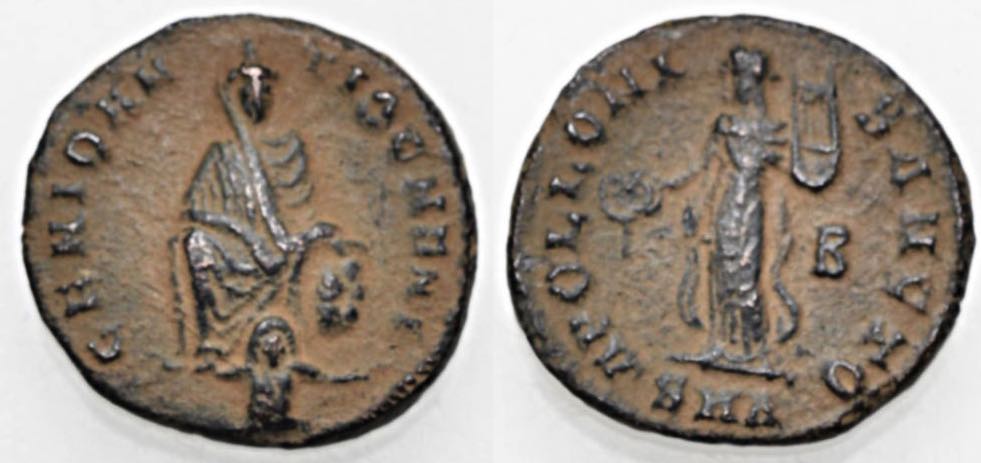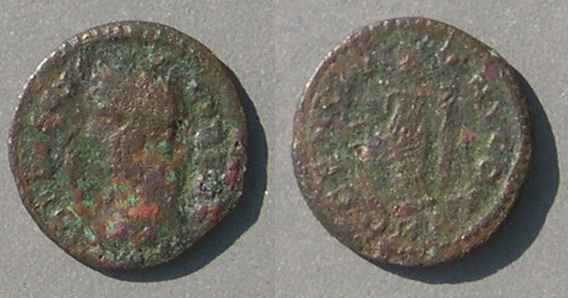also known as "pagan coinage of the Great Presecution of Christians" and as "Civic coinage."
![]() Anonymous civic issues under Maximinus II (AD 310-313)
Anonymous civic issues under Maximinus II (AD 310-313)
also known as "pagan coinage of the Great Presecution of Christians" and as "Civic coinage."
The coin to the right is anonymous, with the mint (Antioch) named but not the emperor. It is 15 mm, 2.32 grams, with IOVI CONSERVATORI and Jupiter seated left/VICTOR-IA AVGG/Victory left with wreath and palm, H (officina 8) in right field and ANT in exergue, for the Antioch mint. Reference: Vagi 2955. van Heesch (1993) type 2, plate 11.2. Sear IV 14932.
A short series of anonymous coins with pagan themes was struck under Maximinus II. The coins are not in RIC. They should be in volume VI with coins of Maximinus II, but in 1973 when volume VI was published, this series of pagan types was thought to belong under Julian II, the Apostate, whose coins would eventually be in volume VIII. However, by 1981 when volume VIII was published Johan van Heesch had convincingly demonstrated (in 1975) they belonged under Maximinus II, so they were omitted from RIC VIII and it was too late to put them in volume VI where they belonged.
Next is another type from Antioch:

16-15 mm. [All photos are to the same scale.] 1.87 grams.
GENIO AN-TIOCNENI, Antioch seated facing, river god swimming below
APOLLONI-SANCTO, Apollo holding patera and lyre
B for the second officina) in the right field. SMA in exergue (Sacra Moneta Antioch).
Vagi 2954. van Heesch, type 3, plate 11.3. (96 examples). Sear IV 14927.
Not in RIC, but common anyway.
van Heesch (1975) was able to use the mintmarks and especially the large number of active officina (11 officina from A to IA) to show that the whole series was from the time of the persecutions of Christians under Maximinus II (May 310 to July 311), not Julian II (360-363). In his 1993 article he revised the date to between the end of 311 and December 312, a period of renewed persecutions of Christians.
 17 mm. 1.45 grams.
17 mm. 1.45 grams.
No legend, either side.
Veiled and turreted head of Tyche right
Apollo standing left holding patera and lyre.
The reverse is similar to the reverse of the previous type, suggesting it is from Antioch.
Vagi 2957. Sear IV 14929. van Heesch type 5, plate 11.8 (2 examples)
[This type without legend was first published, as unique, in August 1986 in the sale catalog Elsen 91, lot 366]
Vagi 2956, van Heesch type 4, plate 11.4 has the same designs on both sides, however with legends on both sides:
GENIO CIVITATVS/APOLLOINI SANCTO, confirming the similarity with the previous reverse.
 13 mm. 1.24 grams [This example corroded]
13 mm. 1.24 grams [This example corroded]
DEAE SANC CERERI, bust of Ceres left
GEN CIVIT NICOM, Genius of Nicomedia standing left holding rudder and globe
OPA in exergue. [The interpretation of this is obscure.]
van Heesch type 1, plate 11. 1.
Sear IV 14931.
 16-15 mm. 1.90 grams.
16-15 mm. 1.90 grams.
DEO SANCTO SARAPIDI, head of Serapis with modius on head
DEO SANCTO NILO, Nilus reclining left holding reeds and cornucopia
ALE in exergue, for Alexandria.
Sear IV 14930. van Heesch type 6, plate 11.9 (10 examples)
The same types and legends appear on a coin with only 13 mm diameter (instead of 16 mm): van Heesch 7, plate 11.10 (#7 below).
The same designs also appear on a 13 mm coin with abbreviated legends:
DEO SARAPIDI/SANCTO NILO, van Heesch type 8, plate 11.11 (#8 below).
One more small type is c. 11 mm with this obverse design and legend DEO SARAPIDI
and reverse GENIO ALEXAND, Alexandria reclining left with rudder in her right hand. van Heesch type 9, plate 11.12 and 13 (#9 below).
The types according to van Heesch (1993):
|
van Heesch |
obverse (Size in mm.) |
reverse | image from above, reduced |
van Heesch no. |
| 1 Vagi -- Sear IV 14931 |
DEAE SANC-CERERI |
GEN CIVI-T NICOM Fortuna standing with rudder and cornucopia OPA in ex. |
 |
4 |
| 2 Vagi 2955 Sear IV 14932 |
IOVI CONS-ERVATORI Jupiter seated left (15 mm.) |
VICTOR-IA AVGG Victory left ANT in ex. Officina number in field |
46 | |
|
3 |
GENIO AN-TIOCHENI Antioch seated, river-god below (16 mm.) |
APOLLONI SANCTO Apollo standing left SMA or AMS in ex. |
 |
96 |
|
4 |
GENIO CI-VITATIS Turreted bust of Antioch (Tyche) (17 mm.) |
APOLLONI SANCTO Apollo standing left (as #3) |
(Type as next, but with legends) | 2 |
| 5 Vagi 2957 Sear IV 14929 |
Both sides as #4, but anepigraphic (17 mm) |
 |
2* | |
| 6 Vagi 2959 Sear IV 14930 |
DEO SANCT-O SARAPIDI |
DEO SANCTO NILO Nilus reclining left ANE in ex. officina number in field |
 |
10 |
| 7 Vagi -- |
Both sides as # 6 but the coin is smaller (13-14 mm) |
(Type as above, #6, but smaller) | 2 | |
| 8 Vagi 2960 Sear IV 14933 |
DEO SA-RAPIDI Head of Sarapis right (11-13 mm) |
SANCTO NILO Nilus reclining left ALE in ex. |
(Design as above, #6, but smaller |
6 |
|
9 |
DEO SA-RAPIDI Head of Sarapis right (as #8) (10.5 mm) |
GENIO A-LEXAND Alexandria reclining left, rudder in right SM or MS in ex. |
(Looks a lot like #6, but much |
3 |
* There are many more examples of each type than van Heesch found in 1993. I have notes on at least 8 examples of type #5 without legend in sale catalogs and at least 7 examples of type #4 with legends (and I stopped taking notes in 2009). The proportions in the table might be about right, but it is likely the rarer ones are somewhat overrepresented because they attract more attention.
Galerius (293-305-311) with a similar legend.
A new type has come to light which raises more questions than it answers. It has a reverse legend similar to the previous type.
 17.5 mm. 2.10 grams.
17.5 mm. 2.10 grams.
Galerius, 293-305-May 311.
Caesar 293-305.
MAXIMIANVS CAESAR, radiate, draped, bust right
DEO SANC-TO SERAPIDI, Serapi standing, head right, holding long staff
E in right field, ALE in exergue.
The reverse legend, but not the design, is as the obverse legend on the previous type, except for spelling SEPAPIDI with SE instead of SA. However, both feature Serapis with his modius on his head. ex CNG e-sale398, lot 585. Otherwise unpublished.
No reverse or obverse legend in RIC VI (AD 294-313) or VII (AD 313-337) begins with "DEO". This obverse legend is not listed at Alexandria for Galerius and is extremely rare elsewhere and then only on gold aurei and silver argentei, not copper. So, it is not just a minor variant on a known type, nor is it a mule of an obverse and reverse issued at the same time that should not have been combined. There are no other examples of this obverse and no other examples of this reverse.
The timing is wrong for this to be associated with the anonymous series. Galerius was Augustus and not Caesar after 305, and his legend MAXIMIANVS CAESAR is, in RIC, associated with the first silver argentei of the reign and dated c. 294 at most mints. Assuming this coin is genuine and official, it demonstrates that the legend "DEO SANC-TO SERAPIDI" was in use even before the anonymous series.
References:
These types are not in RIC.
van Heesch, Johan. "The last civic coinages and the religious policy of Maximinus Daza, A.D. 312," Numismatic Chronicle, 153, 1993, p. 65-76.
van Heesch, Johan. "Frappe semi-autonom sous Maximin Daza" RBN 121 (1975) 91-108.
Vagi, David. Coinage and History of the Roman Empire, 1999, pages 516-517, lists 7 types (see the table above).
For an excellent web site on these with more analysis, comparsions with contemporary coins, and reasons for dating them slightly differently than van Heesch did, see David Kalina's site: http://allcoinage.com/anonymous_civic.php
Go to a page of links to web pages about coins of the tetrarchies and later, 284-324.
Return to the Table of Contents page for this entire site.